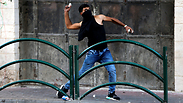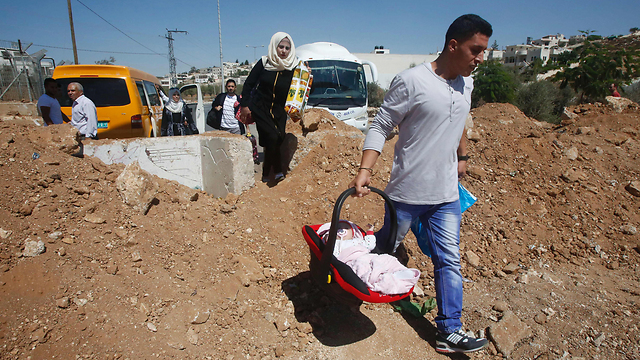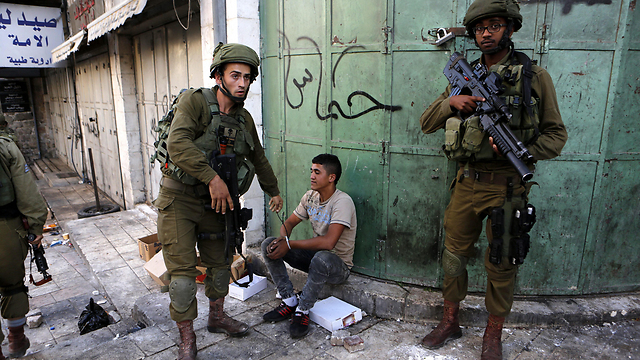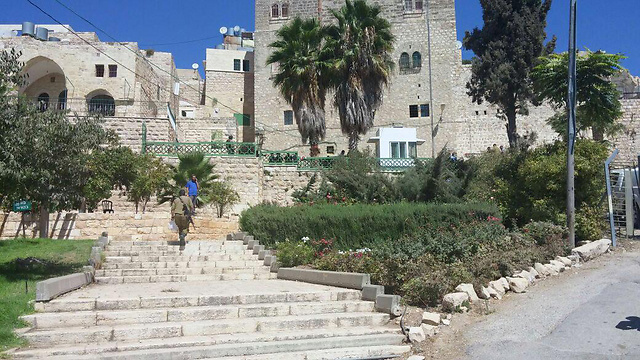
Where death reigns
Op-ed: The young Palestinians heading to IDF roadblocks are not doing it for the sake of Palestine, for the sake of Islam or for the sake of killing Jews. Their goal is to die, and the soldiers are their tool.
Two young people left the village recently to carry out terror attacks and did not return – one was killed, the other was seriously wounded. After these two, there was bound to be a third one. And he in fact arrived. When the soldiers at the roadblock ordered him to stop, the terrorist pulled out a knife. They shot to wound him. He flashed the knife and was killed.
They are not dying for the sake of Palestine, they are not dying for the sake of Islam or for the sake of killing Jews; they are dying for the sake of despair, in order to sanctify themselves. The goal is to die; the soldiers are the tool.
It's the exact opposite of what happened in the previous waves of terror, when the soldiers were the goal and death was the tool. Like Bara'a Ramadan Owaisi – the 12-year-old girl who arrived Wednesday at the Eliyahu crossing with a bag containing no weapon, not even a knife, and refused to obey the soldier's orders – told her investigators: "My father earns a meager salary at the Qalqilya Municipality, my mother is unemployed. I wanted to die." She ended up with a wounded knee.
I spent Tuesday in Hebron, which is called H2 in the agreements, an area where 40,000 Palestinians and 400 Jews were supposed to live under Israeli rule. The numbers have changed: The Arabs declined by several thousand, the Jews grew by several hundred.
What remains unchanged is the depression. Every time I arrive in Hebron, I am struck by the depression all over again. There is no other place which is more depressing, troubling, hostile between the Jordan River and the Mediterranean Sea – not even Gaza's refugee camps.
The Shuhada checkpoint is one of the crossings between the two parts of the city. Not exactly Checkpoint Charlie. Occasionally, youth on the Palestinian side throw stones at the Nahal soldiers on the Israeli side. The soldiers respond with stun grenades and teargas. The gas burns.
A Palestinian family – a father, a mother and three small children – walks on the desolate street, which the Arabs call Shuhada and the Jews call King David. The mother is the first to smell the gas. She warns the children, and they quickly cover their faces with the edge of their shirt. The children don’t cry, don’t complain. They were born into the gas.
The depression was borne from the closed shops: There used to be hundreds of shops on this part of Hebron and all of them, apart from a few which received a permit to open, are locked with iron doors; it was borne from the fences, barbed-wire fences and net fences and security fences; from the abandoned homes; from the uncleared trash; from the large number of soldiers everywhere; and mainly from the emptiness, the silence, like a battlefield, like no man's land. Death reigns here, wrote Yoram Taharlev in The Ballad of Yoel Moshe Salomon. Salomon heard birds sing and relaxed. In Hebron there are no birds; the gunshots drive them away.
'Take them all away'
Near the Cave of the Patriarchs, opposite the Jewish souvenir shop, there is a store offering tourists pottery items – red clay pomegranates for the Jewish New Year, Armenian-style saucers, hookah stands."I don't sell my goods here," says the owner, Muhammad. "I sell at Jaffa's flea market, at stores in Tel Aviv." He is 48 years old and meticulously dressed. He has an apartment on the Israeli side and an apartment on the Palestinian side. His car is there too. "At nine they lock the gates," he explains. "If you're stuck, you're stuck."
Why do the young ones carry out terror attacks, I ask. "There is no work, no money," says Muhammad. "If (someone) gets a job, how much will he earn? Maybe 1,500 shekels (about $400) a month. He can't go to Jerusalem, to Tel Aviv, to the sea. The youth have nothing left to be afraid of."
His worker sits at the store's entrance and paints the Armenian saucers, with the hand of an artist, before they are put in the oven. He raises his head. "It's one big prison," he says. "One big prison."
"These young people are not thinking about Palestine," Muhammad says. "They have nothing to lose. If this situation continues, everything will blow up."
What's the solution, I ask.
"How much is 4000 divided by five?" Muhammad responds with a question. "Eight, right? There are 50 seats on a bus, 400 Jews in Hebron. They should bring eight Egged buses and take them all away."
He looks at me as a winner. There is such a simple solution, so easy, and no one has thought about before.
Two states? I ask.
"One state," he rules. "Without Abu Mazen (Palestinian President Mahmoud Abbas) and without (Prime Minister Benjamin) Netanyahu."
The humiliated children
IDF officials belieced that the wave of violence would resume a year after it began.
"We said, let's see what we have learned, how we can improve. We are a learning organization," says a military source.
An analysis of the first attacks revealed that knives can kill or wound citizens, mainly women. An encounter between soldiers and a knife usually ends better.
Then came the shooting attacks. In most cases, the weapons were locally produced, "improvised weapons." It turned out that there are professionals behind the improvisation: There is a thriving weapon industry in the West Bank. The rifle they manufacture – or create from an air rifle – is an efficient tool. It can fire a semi-authomatically and automatically. This was the type of rifle used in the attack at Tel Aviv's Sarona compound.

The IDF shut down 30 Palestinian arms factories, the largest one in Bethlehem. The machines discovered in Bethlehem were of a high automation level. The owner was arrested, and as a result of the arrests, the prices of weapons in the West Bank have increased. A locally-manufactured Carl Gustav, which cost NIS 2,000 ($530) a year ago, costs NIS 4,000 ($1,060) today. An IDF M-16 rifle costs NIS 80,000 ($21,260).
Most of the vehicles used in vehicular attacks were old cars which were sold in Israel to be used as scrap metal. In Arabic they are called "mashtuba" (erased). Instead of being dismantled, they reached the West Bank. The police and army acted against the merchants.
An effort was made to complete the construction of the separation fence to make it more difficult for terrorists to cross into Israel. Actions were taken to reduce the number of illegal residents. On the other hand, the IDF insisted on continuing to allow the Palestinians to work in Israel legally, transfer money and ease restrictions during the holidays. The government didn't like it, but accepted it. Some 300 terror attacks came out of Jerusalem and the Palestinian territories throughout the year, but according to IDF estimates, 2,000 were thwarted.
The army developed the "expanding split method." The father, the teacher, must be influenced. They may be able to calm the young ones down. The parents receive phone calls. So do the teachers. The call may arrive from Israel or from someone in the Palestinian Authority. Indeed, the teachers played a positive role this year. They explained to the students why going out to the checkpoint carries no hope.
The geographical story is fascinating. In the wave which began last year and died out by April, 40 percent of the terrorists came from seven villages, cities or neighborhoods. Fifty percent of the attacks occurred in seven places.
One hundred cases were selected and fully investigated. It turned out that each one had a personal story: Humiliated children. Not people from the margins of society, like in the previous intifada, but from good families. But each youth carrying a load on their back.
This explanation doesn’t say much: After 50 years of occupation, every Palestinian teenager has a personal issue – a relative who was killed or one who is sitting in prison, humiliation at a checkpoint, pressure by the Shin Bet and IDF, pressure by the Palestinian security apparatus, destroyed families, etc. It's not the problem that has changed but the solution. There is a solution: Being a shahid (martyr).
"It's a virus," says a military source. "Like a virus comes, it goes away and comes back. There are people who are more sensitive to the virus and people who are less sensitive."
It's easy, perhaps too easy, to explain why the virus has returned: The anniversary, Eid al-Adha, the upcoming High Holy Days, which announce the mass arrival of Jews on the Temple Mount, the killing of children, including a four-year-old girl who crossed Road 60, the Jerusalem-Hebron Road, and was run over by a settlement resident. The Palestinians didn’t ask themselves what a four-year-old was doing on an interurban road. They compared the running over to murder.
And in just a few weeks, the olive picking season begins.












